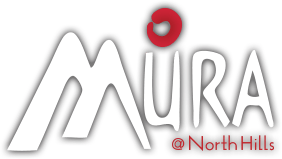Can I use butcher block for a table? Yes, you can use a butcher block for a table. Butcher block is a type of wood that is typically used for cutting boards or countertops. However, it can also be used for furniture, such as tables.
Butcher block tables are typically made from hardwood, such as maple or oak. They are then finished with a food-safe sealant to protect the wood.
- Decide on the size and shape of your table
- Cut the butcher block to the desired size and shape
- Sand the edges of the butcher block to smooth them out
- Apply a food-safe finish to the butcher block
- Attach the butcher block to the base of the table
- Enjoy your new table!
Table of Contents
How to make a thick butcher block table

When it comes to making furniture, a thick butcher block table is a great option. Not only is it sturdy and durable, but it can also add a touch of rustic charm to your home. Here’s how you can make your own thick butcher block table:
1. Start by finding a solid piece of wood that is at least 2 inches thick. You can either use a piece of lumber or an old door. If you’re using an old door, make sure to sand it down and remove any paint or varnish.
2. Cut the wood to the desired size for your table. If you’re using a door, you may need to cut it down to fit your table’s dimensions.
3. Once the wood is cut to size, use a hand saw, or power saw to make cuts into the wood that are about 1 inch deep. These cuts will serve as the slots for the butcher block pieces.
4. Next, cut the butcher block pieces to fit into the slots you just cut. Make sure the pieces are snug so that they don’t move around.
5. Once all the pieces are in place, use a hammer and nails to secure the butcher block top to the table. Start by nailing the pieces along the outside edge and then work your way in.
6. Finally, finish the table by sanding down any rough edges and applying a sealant.
You can use a clear polyurethane or a beeswax finish. Let the table dry completely before using it.
Butcher block tabletop
When it comes to kitchen countertops, there are many options to choose from. One popular option is a butcher block table top. Butcher block table tops are made from solid hardwood, making them durable and long-lasting.
They are also easy to clean and maintain. Butcher block table tops can provide a warm and natural look to your kitchen. If you are considering a butcher block table top for your kitchen, there are a few things to keep in mind.

First, you need to decide what type of wood you want. There are many different types of hardwoods to choose from, each with its own unique grain and color. Second, you need to decide on the finish.
You can choose from a natural finish, stained finish, or even a painted finish. Butcher block table tops are a great option for those who want a durable and long-lasting countertop. They are also easy to clean and maintain.
If you are considering a butcher block table top for your kitchen, keep these things in mind to help you make the best decision for your space.
Butcher block dining table Ikea
When it comes to kitchen tables, there are a lot of different materials and designs to choose from. But if you want something that is both stylish and functional, a butcher block dining table is a great option. A butcher block table is typically made from hardwood, which makes it very durable.
It is also easy to clean and maintain, which is ideal for a kitchen table. One of the great things about a butcher block table is that it can easily be customized to fit your specific needs. For example, you can get a table with built-in storage or one that is extendable to accommodate more people.
If you are looking for a new kitchen table, a butcher block dining table from IKEA is a great option to consider.
Butcher block table plans
If you’re thinking about adding a butcher block table to your kitchen, you’re not alone. Butcher block tables are becoming increasingly popular in home kitchens, thanks to their durability, versatility, and stylish good looks. Before you start shopping for a butcher block table, it’s important to have a plan.

Here are a few things to consider:
What size table do you need?
Butcher block tables come in a variety of sizes, so it’s important to measure your space and decide on the right dimensions for your table.
What type of wood do you want?
Butcher block tables are typically made from hardwoods like maple or oak. But you can also find tables made from other materials like bamboo or stainless steel.
What style do you want?
Butcher block tables come in a variety of styles, from classic and traditional to modern and contemporary. Decide on the look you’re going for before you start shopping.
What features do you want?
Butcher block tables can come with a variety of features, like drawers, shelves, or cabinets. Decide which features are most important to you, and look for tables that have them.
What’s your budget?
Butcher block tables can range in price from a few hundred dollars to a few thousand. Decide how much you’re willing to spend before you start shopping.
Once you’ve considered all of these factors, you’re ready to start shopping for your butcher block table. Keep your plans in mind, and you’re sure to find the perfect table for your kitchen.
Legs for butcher block table
If you’re looking for a sturdy, reliable table for your butcher block, you’ll want to make sure it has legs that can support the weight. Butcher block tables can be quite heavy, so it’s important to choose legs that are made from a strong material. Metal legs are a good option, as they’re typically very sturdy and can support a lot of weight.
You can also find legs made from wood, but make sure to choose a hardwood like oak or maple that can support the weight of the butcher block. When choosing legs for your butcher block table, make sure to measure the height of the table to ensure the legs are the right size. You’ll also want to consider the width of the legs to make sure they’ll fit comfortably under the table.
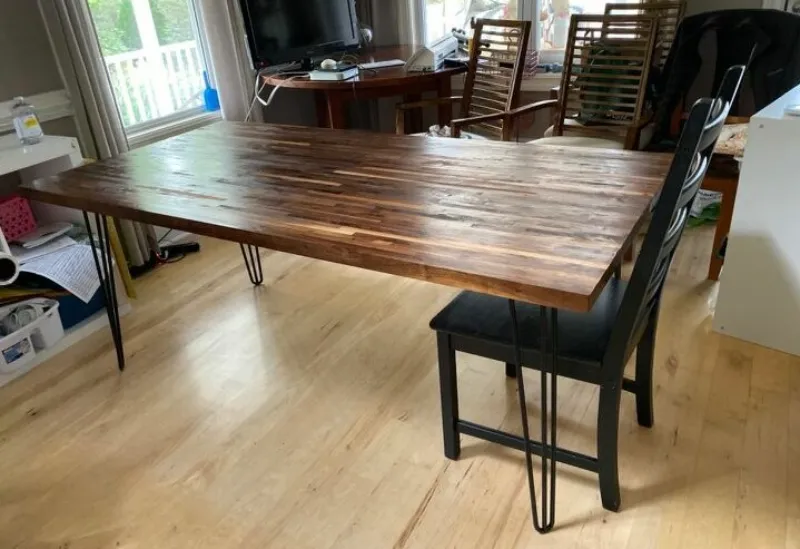
Butcher block tables can be quite wide, so make sure to measure the width of the legs before making your purchase. Once you’ve chosen the perfect legs for your butcher block table, it’s time to install them. If you’re not comfortable doing this yourself, you can always hire a professional to do it for you.
But if you’re handy with tools, installing the legs is relatively easy. Just make sure to use the proper screws and brackets to ensure the legs are securely attached to the table. With a little bit of effort, you can easily find the perfect legs for your butcher block table.
Just make sure to measure the table and choose legs that are strong enough to support the weight. With the right legs, your butcher block table will be a sturdy, reliable piece of furniture that will last for years to come.
Butcher block table plans free
If you’re looking for a traditional kitchen table with a warm and natural look, butcher block tables are a great option. And if you’re the handy type, you can save money by building your own butcher block table with these free plans. There are a few things to consider before you start building, such as what size table you need and what kind of wood you want to use.
Once you have those details worked out, it’s time to start building! First, you’ll need to cut the pieces for the tabletop and legs. If you’re using hardwood like maple or oak, you’ll want to use a saw with a fine-toothed blade to avoid chipping the wood.
Once all of the pieces are cut to size, it’s time to start assembling the table. Start by attaching the legs to the tabletop. Then, add the aprons and stretchers to reinforce the tabletop and give it some additional strength.
Once the table is fully assembled, you can sand it down and finish it with a sealer or stain of your choice. With a little time and effort, you can build a beautiful and sturdy butcher block table that will last for years to come. So get started today and enjoy the satisfaction of knowing you built it yourself!
Butcher block counter height table
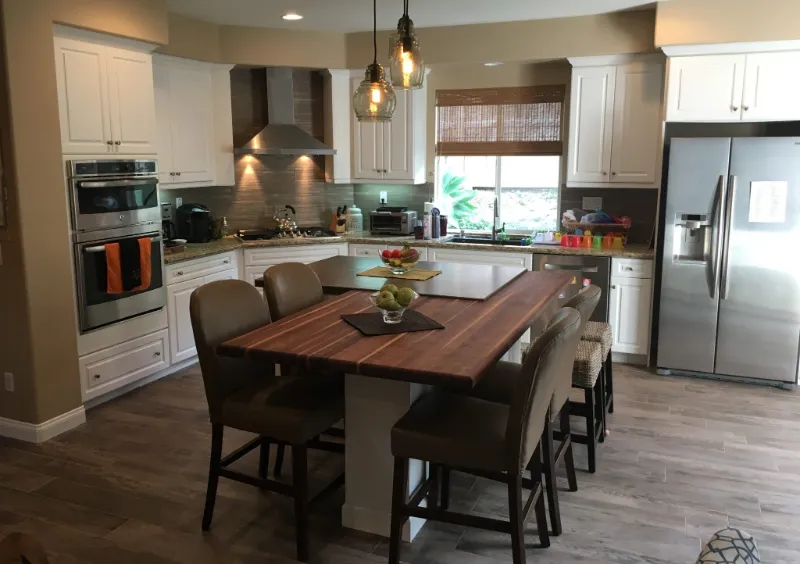
Are you looking for a new kitchen table? If so, you may be considering a butcher block counter height table. Butcher block tables are a great option for many kitchens because they are durable, easy to clean and look great.
Here are a few things to consider before you purchase a butcher block table:
Size
Butcher block tables come in a variety of sizes. You will want to choose a size that fits well in your kitchen and can accommodate the number of people you typically have at your table.
Shape
Butcher block tables are typically rectangular, but they can also be round or oval. Consider the shape of your kitchen and the amount of space you have when choosing a table. Finish: Butcher block tables can be left unfinished, stained, or sealed.
Unfinished tables will need to be sealed periodically to protect the wood. Stained tables will have a richer color, but you will need to be careful not to scratch or stain the wood. Sealed tables are the easiest to care for, but they may not have as much character as an unfinished or stained table.
Cost
Butcher block tables range in price depending on the size, shape, and finish. Unfinished tables are typically the most affordable, followed by stained tables. Sealed tables are the most expensive, but they require the least amount of maintenance.
Now that you know a little more about butcher block tables, you can start shopping for the perfect one for your kitchen. Be sure to measure your space and consider the shape and finish that you want before making your purchase.
What kind of wood should I use to make a butcher block table?
When it comes to wood for butcher block tables, there are a few different options to choose from. The most popular option is hard maple, as it is incredibly hard and durable. Other good choices include beech and birch.
Avoid using softer woods like pine, as they will be more susceptible to nicks and cuts. If you’re looking for a more affordable option, you can also find butcher block tables made from laminate.
How do you finish a butcher block table?
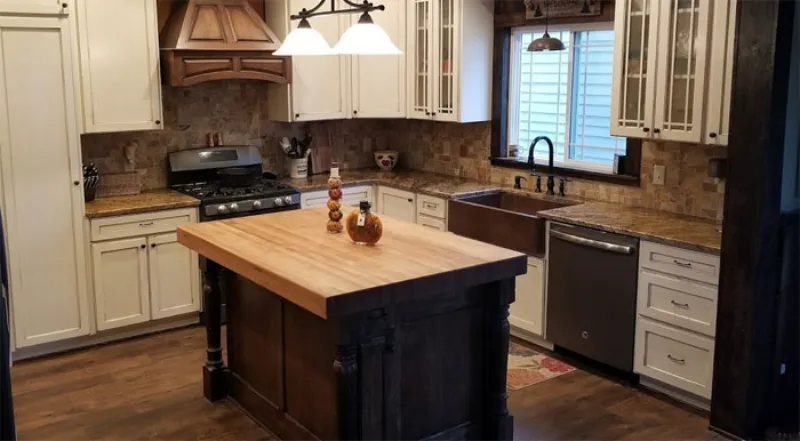
If you’re looking to add a natural and rustic touch to your home, a butcher block table is a great option. But how do you finish a butcher block table? There are a few different ways you can finish a butcher block table, but the most common method is to use food-safe mineral oil.
First, clean the table with a mild soap and water solution. Then, apply the mineral oil to the table with a clean cloth, working it into the wood in a circular motion. Allow the oil to soak in for at least 30 minutes, then wipe off any excess.
If you want a more durable finish, you can also use a beeswax finish. First, clean the table with a mild soap and water solution. Then, apply a thin layer of beeswax to the table with a clean cloth, working it into the wood in a circular motion.
Allow the wax to soak in for at least 30 minutes, then buff it to a shine with a clean, dry cloth. No matter which finishes you choose, be sure to reapply it every few months to keep your butcher block table looking its best.
How thick should a butcher block table be?
There is no definitive answer to this question as it depends on a number of factors, such as the intended use of the table, the type of wood being used, and the preference of the individual. However, a good rule of thumb is that a butcher block table should be at least 1.5 inches (3.8 cm) thick. This thickness will provide adequate stability and durability for most uses while still allowing the table to be easily moved and stored if necessary.
Thicker butcher block tables may be better suited for heavy-duty use, such as in a commercial kitchen, while thinner tables may be more appropriate for lighter use, such as in a home kitchen. Ultimately, the decision of how thick to make a butcher block table is up to the individual, and it is important to consider all factors before making a final decision.
How do you make a butcher block top table?
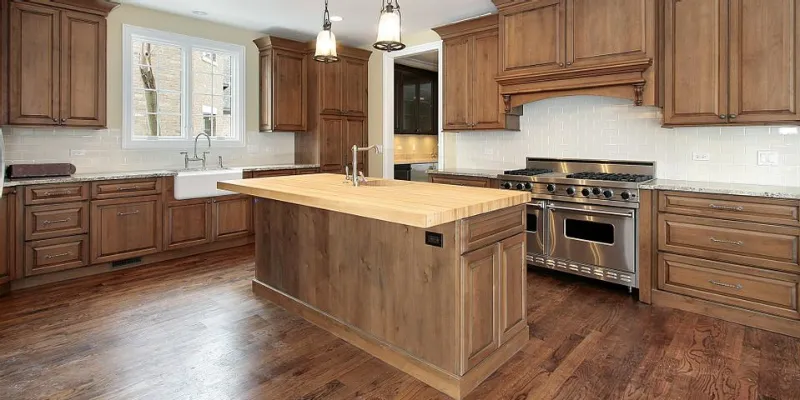
If you’re looking to add a touch of rustic charm to your home, a butcher block top table is a great option. Butcher block tables are easy to make yourself, and they make a great addition to any kitchen or dining room. Here’s how to make your own butcher block top table:
First, you’ll need to gather some supplies. You’ll need a piece of butcher block (you can find this at most home improvement stores), some wood glue, clamps, sandpaper, and a drill. You’ll also need a saw to cut the butcher block to size.
Once you have your supplies, it’s time to get to work. Start by sanding down the butcher block. This will help the wood glue to adhere better.
Then, measure and cut the butcher block to the desired size. Next, apply a generous amount of wood glue to the top of the table. Place the butcher block on top of the glue, and then use the clamps to secure it in place.
Let the glue dry for at least 24 hours. Once the glue is dry, you can drill holes for any hardware you want to add. This could include handles, drawer pulls, or even a shelf.
Just be sure to drill the holes before you add any finish to the table. Finally, finish the table by sanding it down and adding a stain or sealant of your choice. You can also leave the table natural for a more rustic look.
That’s it! Your new butcher block top table is now complete. Enjoy your handiwork and the added charm it brings to your home.
How to Build a Desk with Butcher Block – Hardwood Reflections
Conclusion
If you’re considering using butcher block for a table, there are a few things you need to keep in mind. First, the butcher block is a softer wood, so it’s more susceptible to scratches and dents. Second, it needs to be properly sealed to protect it from moisture.
And third, it’s important to choose a high-quality butcher block that will last for years. With a little research and care, you can use a butcher block for a beautiful and durable table.
G Patel has been honing his craft in the restaurant industry for over 25 years. After graduating from North Carolina State University with a degree in business, G set out to turn Eschelon Hospitality into a recognized brand throughout Carolina’s state restaurants; and he did just that when acquiring Mura North Hills. Since then, it has become an iconic sushi-serving establishment.
